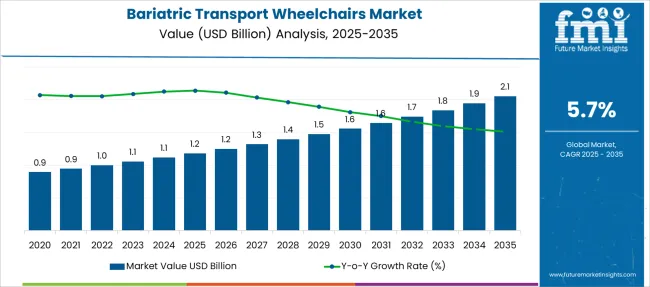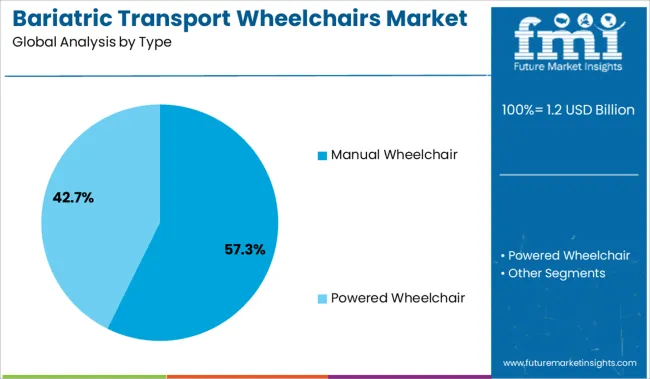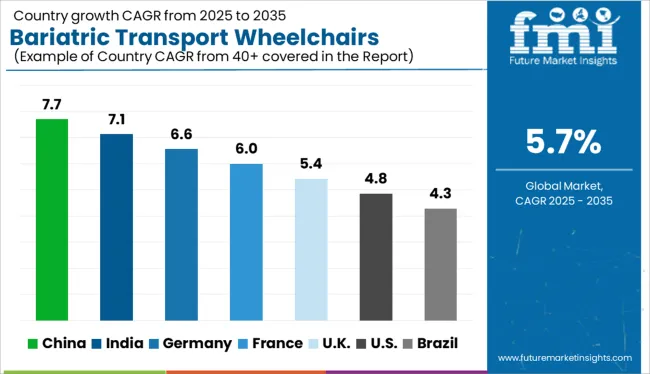The Bariatric Transport Wheelchairs Market is estimated to be valued at USD 1.2 billion in 2025 and is projected to reach USD 2.1 billion by 2035, registering a compound annual growth rate (CAGR) of 5.7% over the forecast period.

| Metric | Value |
|---|---|
| Bariatric Transport Wheelchairs Market Estimated Value in (2025 E) | USD 1.2 billion |
| Bariatric Transport Wheelchairs Market Forecast Value in (2035 F) | USD 2.1 billion |
| Forecast CAGR (2025 to 2035) | 5.7% |
The bariatric transport wheelchairs market is experiencing substantial growth driven by the global rise in obesity prevalence, aging populations, and the demand for specialized mobility solutions in both clinical and non clinical environments. Increasing healthcare infrastructure investments, particularly in long term care and rehabilitation centers, have supported the adoption of transport wheelchairs designed to accommodate higher weight capacities and provide enhanced comfort.
Technological advancements in lightweight yet durable materials, along with ergonomic frame designs, are improving patient mobility and safety. Regulatory emphasis on patient care standards and institutional readiness for bariatric needs is also reinforcing the shift toward specialized transport solutions.
The outlook for the market remains favorable as healthcare providers focus on inclusive patient support and improved mobility outcomes in both inpatient and outpatient care settings.
The market is segmented by Type and Application and region. By Type, the market is divided into Manual Wheelchair and Powered Wheelchair. In terms of Application, the market is classified into Institutional Use and Personal Use. Regionally, the market is classified into North America, Latin America, Western Europe, Eastern Europe, Balkan & Baltic Countries, Russia & Belarus, Central Asia, East Asia, South Asia & Pacific, and the Middle East & Africa.

The manual wheelchair segment is projected to account for 57.30% of total revenue by 2025 within the type category, positioning it as the dominant segment. This leadership is supported by its operational simplicity, lower maintenance costs, and versatility in various healthcare environments.
Manual wheelchairs are preferred in institutional settings where mobility assistance is provided by caregivers or staff, minimizing the need for motorized mechanisms. The availability of folding and reinforced frame models tailored for bariatric users has enhanced usability and storage efficiency.
Additionally, affordability and ease of integration into transport and transfer routines make manual wheelchairs a preferred option for healthcare facilities managing diverse patient mobility requirements.

The institutional use segment is anticipated to hold 62.10% of total market revenue by 2025 within the application category, establishing it as the leading end use. This dominance is driven by high demand in hospitals, rehabilitation centers, and long term care facilities where bariatric patients require safe and reliable transport solutions.
Institutions prioritize durable equipment that complies with safety standards and supports efficient patient handling, especially in high traffic environments. Furthermore, the growing number of surgical and non surgical interventions for obese patients necessitates specialized mobility equipment in pre and post operative care settings.
Institutional procurement practices, which often favor long lasting and serviceable equipment, continue to sustain demand for bariatric transport wheelchairs in this segment.
Due to the fact that about one third of the North American population is now obese, wheelchair manufacturers are still reacting slowly to the demand for bariatric mobility equipment, thus providing opportunities for new players in the market. It is estimated that bariatric products are going to be the fastest growing mobility aid segment in the near future.
All this could lead to a greater product innovation and intense competition in the bariatric transport wheelchair market.
The power wheelchair systems possess a front wheel drive, centre wheel drive and rear wheel drive. This fulfils the demand for different driving handling characteristics under varying conditions. Such type of bariatric transport wheelchairs can be used both in the indoor and outdoor environments.
Typically, bariatric transport wheelchairs are used for individuals who weigh over 250 pounds and who have a BMI of greater than 25. Such kind of wheelchairs are built to handle the additional mass to custom products that can accommodate people weighing up to 1000 pounds.
One of the significant mobility challenges for individuals using the bariatric transport wheelchair is the additional width of the wheelchair, which in some cases is as much as 60 inches.
In view of the favourable healthcare policies of the United States government, reimbursement is driving the power wheelchair market. In addition, due to a rapidly aging population, more people are frail and need assistance for mobility. Power wheelchair market was valued at USD 0.9 billion in the year 2020 and is expected to reach USD 1.2 billion in 2025.
Even though the market is recognizing the need for bariatric transport wheelchairs, there are some restrains affecting the growth in this segment. These include a lack of skilled training and knowledge to handle obese patients and there is a lack of caregivers in this particular segment. In addition, there are no specific minimum weight requirements or code to follow in the manufacturing of bariatric transport wheelchairs.

North America and Europe are the most lucrative markets for bariatric transport wheelchairs. Factors such as increasing rates of non-communicable diseases leading to disability and a growing epidemic of obesity are contributing factors driving the growth of bariatric transport wheelchairs market in these regions. In addition, government regulations in the healthcare arena are giving more people access to bariatric transport wheelchairs.
The Asia Pacific region is also exhibiting a robust growth in the bariatric transport wheelchairs market.

21st Century Scientific Inc., Drive Medical Design and Manufacturing, GF Health Products Inc., Invacare Corporation and Karman Healthcare are the key market players in North America.
The research report presents a comprehensive assessment of the market and contains thoughtful insights, facts, historical data, and statistically supported and industry-validated market data. It also contains projections using a suitable set of assumptions and methodologies. The research report provides analysis and information according to market segments such as geographies, types and applications.
The global bariatric transport wheelchairs market is estimated to be valued at USD 1.2 billion in 2025.
The market size for the bariatric transport wheelchairs market is projected to reach USD 2.1 billion by 2035.
The bariatric transport wheelchairs market is expected to grow at a 5.7% CAGR between 2025 and 2035.
The key product types in bariatric transport wheelchairs market are manual wheelchair and powered wheelchair.
In terms of application, institutional use segment to command 62.1% share in the bariatric transport wheelchairs market in 2025.






Our Research Products

The "Full Research Suite" delivers actionable market intel, deep dives on markets or technologies, so clients act faster, cut risk, and unlock growth.

The Leaderboard benchmarks and ranks top vendors, classifying them as Established Leaders, Leading Challengers, or Disruptors & Challengers.

Locates where complements amplify value and substitutes erode it, forecasting net impact by horizon

We deliver granular, decision-grade intel: market sizing, 5-year forecasts, pricing, adoption, usage, revenue, and operational KPIs—plus competitor tracking, regulation, and value chains—across 60 countries broadly.

Spot the shifts before they hit your P&L. We track inflection points, adoption curves, pricing moves, and ecosystem plays to show where demand is heading, why it is changing, and what to do next across high-growth markets and disruptive tech

Real-time reads of user behavior. We track shifting priorities, perceptions of today’s and next-gen services, and provider experience, then pace how fast tech moves from trial to adoption, blending buyer, consumer, and channel inputs with social signals (#WhySwitch, #UX).

Partner with our analyst team to build a custom report designed around your business priorities. From analysing market trends to assessing competitors or crafting bespoke datasets, we tailor insights to your needs.
Supplier Intelligence
Discovery & Profiling
Capacity & Footprint
Performance & Risk
Compliance & Governance
Commercial Readiness
Who Supplies Whom
Scorecards & Shortlists
Playbooks & Docs
Category Intelligence
Definition & Scope
Demand & Use Cases
Cost Drivers
Market Structure
Supply Chain Map
Trade & Policy
Operating Norms
Deliverables
Buyer Intelligence
Account Basics
Spend & Scope
Procurement Model
Vendor Requirements
Terms & Policies
Entry Strategy
Pain Points & Triggers
Outputs
Pricing Analysis
Benchmarks
Trends
Should-Cost
Indexation
Landed Cost
Commercial Terms
Deliverables
Brand Analysis
Positioning & Value Prop
Share & Presence
Customer Evidence
Go-to-Market
Digital & Reputation
Compliance & Trust
KPIs & Gaps
Outputs
Full Research Suite comprises of:
Market outlook & trends analysis
Interviews & case studies
Strategic recommendations
Vendor profiles & capabilities analysis
5-year forecasts
8 regions and 60+ country-level data splits
Market segment data splits
12 months of continuous data updates
DELIVERED AS:
PDF EXCEL ONLINE
Bariatric Surgery Device Market Forecast and Outlook 2025 to 2035
Bariatric Walking Aids Market Size and Share Forecast Outlook 2025 to 2035
Bariatric Walkers Market Size and Share Forecast Outlook 2025 to 2035
Bariatric Rollator Walkers Market Size and Share Forecast Outlook 2025 to 2035
Bariatric Lifts Market Size and Share Forecast Outlook 2025 to 2035
Bariatric Patient Room Market Size and Share Forecast Outlook 2025 to 2035
Bariatric Beds Market Analysis and Forecast for 2025 to 2035
Transport Cases & Boxes Market Size and Share Forecast Outlook 2025 to 2035
Transportation and Security System Market Size and Share Forecast Outlook 2025 to 2035
Transport Management System Market Size and Share Forecast Outlook 2025 to 2035
Transportation Biofuel Market Size and Share Forecast Outlook 2025 to 2035
Transportation Infrastructure Construction Market Size and Share Forecast Outlook 2025 to 2035
Transportation Aggregators Market Size and Share Forecast Outlook 2025 to 2035
Transport Fuel Cell Market Size and Share Forecast Outlook 2025 to 2035
Transportation Based Hydrogen Energy Storage Market Size and Share Forecast Outlook 2025 to 2035
Transportation Analytics Market Analysis - Size, Share, and Forecast Outlook 2025 to 2035
Transport Protein Assays Kits Market Trends - Industry Forecast 2025 to 2035
Transportation Condensing Units Market Growth – Trends & Forecast 2025 to 2035
Market Share Distribution Among Transport Cases & Boxes Providers
Transport Packaging Market from 2025 to 2035

Thank you!
You will receive an email from our Business Development Manager. Please be sure to check your SPAM/JUNK folder too.
Chat With
MaRIA